#selection procedure
Explore tagged Tumblr posts
Text
The CGPSC Professor 2021 Re Open Online Recruitment 2024 has officially begun. The Chhattisgarh Public Service Commission (CGPSC) invites eligible candidates to apply for 595 vacancies across various subjects, including Hindi, English, Political Science, and Economics. This recruitment drive is an excellent opportunity for those with a strong academic background and a passion for teaching. Interested candidates should review the application process, eligibility criteria, and other key details below.
#Professor Recruitment#CGPSC (Chhattisgarh Public Service Commission)#Online Application#CGPSC Recruitment 2024#Academic Positions#CGPSC Online Form#Job Notifications#Selection Procedure
0 notes
Text

@scary-ivy what I’m trying to say is that I wish “top surgery scars” were normalized rather than fetishized- I don’t like that people can look at my body and make huge assumptions about my gender identity and medical history. I don’t like that there are peculiar beauty standards for mastectomy scars, and that having said scars is seen as a Trans Thing when there are trans men with flat chests that don’t have double incision scars. Generally speaking, I think activism wise the movement has gone about visibility and awareness in a way that isn’t helpful & is somewhat regressive/irresponsible.
#all my little words#like there are procedures that aren’t mastectomies that leave people with similar scars#but now more people will assume oh that’s a trans person if they see them#which isn’t great if you want to be selective with who you let in on your history
49 notes
·
View notes
Text
weird dream of the day - had to race pepe marti(?) in karts around the indianapolis motor speedway for a spot in the red bull junior team
3 notes
·
View notes
Text
🌸 was on an hour and a half call with their parents so i took the opportunity to commit crimes (washed a sinkful of dishes, cleaned out the fridge, grocery shopped)
now i am reaping my reward (🌸 chops onions for me and permits me to recite selected edward lear limericks to them)
#i'm trying to get back into reading things that aren't detective novels‚ financial crime nonfiction‚ or technical reports on plane crashes#and am apparently operating on the selection procedure of 'everything i can remember peter wimsey quoting ebulliently'#so. first the old man of whitehaven. next some tennyson. after that god knows. king lear?????#box opener
6 notes
·
View notes
Text
The Sins watch 'The Exorcist' in theaters in 1974!

"N-no… it can't be…."

"I'm going to be sick..!"

"I can't watch any further!"

"I'm going to cry!!"

"I can't stand it!!"

"No more!! No more!!"
The Crew race out of the theater, crying out in terror, with Rashid even vomiting in a nearby trash can. And the only one left in the theater is…..
…Phoebus, frustrated at the rest of the Crew's weak stomachs.

"It's called a carotid angiography! They're just putting dye into her blood so they can perform an X-ray of her blood vessels! You're hardly phased by scary souls, sea creatures, dead bodies and murders and bloodshed, but THIS is what makes you all flee in terror?!"
#[The Sin Crew Watches]#LMAO why don't I do more posts of Phoebus' hilariously selective squeamishness/absence of such#I was going to make a post of Ruixiong in the present watching this by himself or meeting with Gio and Guy in theatres#but then I realized#the ones who are going to be the most terrified of the procedure is Rashid (needles) and Frascona (medical procedure strapped to a table)#and tbf having a needle stuck into your throat would make even the unfazeable Abena squeamish#given I had to get a CT scan for my stroke I knew EXACTLY what the procedure was taking place so it wasn't so scary on my part lmao#[Dumb]#blood tw#hospitals tw#[Captain Josep Frascona]#[Abena Frascona]#[Rashid al-Qadar]#[Wang Ruixiong]#[Guy Duchamp]#[Phoebus Duchamp]#[Giovanni Vespucci]
2 notes
·
View notes
Text
i can’t think about libraries very long without disappearing mysteriously into the fog but it is very funny to me when people say that ao3 is an archive. that certainly is a word in its title but by definition it is absolutely not an archive. that’s not how archives work at all. it’s so charming
#just because something is archived somewhere does not mean that place is an archive#and the act of archiving is more than simply hosting or housing an object#there are selection and classification standards#and treatment procedures#it does have a semi controlled vocabulary for metadata#those tag wranglers really have their work cut out for them#but freeform tagging introduces a lot of nuance#just trust me on this#it’s the closest thing to an archive that we’re going to get#but there are actual physical media fanwork archives out there!!!#both of these things serve two very different purposes though#i’d say ao3 functions more like uhhhh#public library if patrons did things byob style#and that was my ten minutes of thinking about the institution of library science this week#i’ll catch yall next time#flynn.txt
1 note
·
View note
Text
How Doctors Personalize the Thread Lift Procedure for Different Skin Types
As we age, the skin loses its natural elasticity and firmness. This often leads to sagging or fine lines on the skin. A thread lift is an excellent, non-surgical technique that tightens and lifts the skin via special threads. Before taking Thread Lift in Noida, one must understand how dermatologists customize the treatment for individual skin types. Every type of skin is different, and a personalized technique ensures the maximum outcome.

The Basics of a Thread Lift Procedure
A thread lift procedure involves inserting threads under the skin to lift and tighten areas that have begun to sag. These threads stimulate collagen production, improving skin texture and overall appearance. The procedure can be done on various facial areas, including the face, neck, and jawline. The best part is that the results are immediate and have minimal downtime.
How Different Skin Types Affect the Thread Lift Procedure
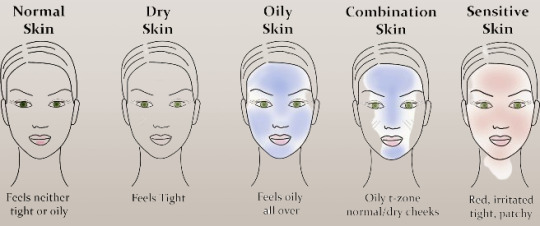
Skin types vary in terms of different characteristics, such as texture, elasticity, oil level, and sensitivity. The dermatologists consider these variables to tailor the thread lift procedure according to the patients. Let's see how the type of skin can affect the treatment.
1. Oily Skin
Oily skin is thicker with larger pores and may require stronger threads for a lift that lasts long. The level of sebum production in such skin can reduce the holding effect of the threads. Doctors will likely opt for certain special types of well-secured thread without sliding.
2. Dry Skin
Dry skin can be even more delicate and irritated. For a person with dry skin, a dermatologist will almost always suggest softer threads that do not incur a probability of scarring or discomfort. In some cases, the thread lift might be used in additional hydration treatments before or after carrying out the procedure to keep the skin moist and healthy-looking.
3. Sensitive Skin
People with sensitive skin require a more cautious approach when it comes to a thread lift. The doctor will use gentler threads and may apply numbing creams or local anaesthesia to ensure minimal discomfort.
4. Mature Skin
Skin loses its elasticity as people age, making it more prone to sagging. In these cases, the dermatologists will use stronger threads to provide more significant lifting effects. The thread insertion may be deeper to address the loss of firmness.
5. Young Skin
A less invasive approach may be used for younger individuals who may just be experiencing early signs of ageing. Thinner, more flexible threads are typically sufficient for creating a subtle lift.
Customized Thread Selection for Better Results
Each type of skin requires different kinds of threads to ensure the best results. There are various options available, including:
PDO (Polydioxanone) Threads: These are commonly used for all skin types and have the advantage of dissolving over time, leaving behind collagen stimulation.
PLA (Poly-L-Lactic Acid) Threads: These are more durable and are suitable for patients looking for longer-lasting results, especially in older skin.
PCL (Polycaprolactone) Threads: PCL threads are stronger and typically used to lift more mature skin or areas requiring more substantial support.
A skilled dermatologist will choose the right procedure based on individual skin needs, ensuring a natural-looking lift.
The Importance of Consultation and Evaluation
Before undergoing a thread lift procedure, it’s essential to consult with a professional dermatologist. They will assess your skin type, texture, and age to determine which treatment plan is best suited for you. This thorough evaluation ensures that the procedure enhances your appearance and complements your skin's natural characteristics.
Aftercare and Follow-Up
After the procedure, dermatologists often provide specific aftercare instructions to maximize the effectiveness of the thread lift. This can include avoiding intense facial expressions, taking prescribed medications, or using specific skincare products to enhance healing. Regular follow-up appointments ensure that any adjustments or additional treatments can be made if necessary.
Conclusion

A personalized approach to thread lift ensures that the treatment is tailored to each individual’s skin type, leading to more effective and lasting results. Whether you have oily, dry, sensitive, or mature skin, dermatologists make adjustments to the procedure to meet your specific needs. For anyone seeking professional guidance, Skinlogics Clinic offers expert consultation and personalized care. Their team of experienced professionals, including a trusted dermatologist in Noida, is committed to providing you with the best possible results.
Original Source:- https://677b8b0fc036f.site123.me/blog/how-doctors-personalize-the-thread-lift-procedure-for-different-skin-types
#Thread Lift in Noida#dermatologist in Noida#Thread Lift Procedure#Skin Types Affect the Thread Lift Procedure#Thread Selection for Better Result#Skinlogics Clinic
0 notes
Text
youtube
Varicocele surgery in India involves the treatment of varicoceles, which are enlarged veins in the scrotum. This procedure is performed to relieve pain, improve fertility, or address testicular atrophy.
#What is Varicocele?#What are the treatments of Varicocele?#What are the different surgery procedures available for Varicocele Condition in India?#How to select a good surgeon and hospital for Varicocele Surgery in India?#What is the Cost of Varicocele Surgery in India?#Youtube
0 notes
Text
"The first modern attempt at transferring a uterus from one human to another occurred at the turn of the millennium. But surgeons had to remove the organ, which had become necrotic, 99 days later. The first successful transplant was performed in 2011 — but even then, the recipient wasn’t immediately able to get pregnant and deliver a baby. It took three more years for the first person in the world with a transplanted uterus to give birth.
More than 70 such babies have been born globally in the decade since. “It’s a complete new world,” said Giuliano Testa, chief of abdominal transplant at Baylor University Medical Center.
Almost a third of those babies — 22 and counting — have been born in Dallas at Baylor. On Thursday, Testa and his team published a major cohort study in JAMA analyzing the results from the program’s first 20 patients. All women were of reproductive age and had no uterus (most having been born without one), but had at least one functioning ovary. Most of the uteri came from living donors, but two came from deceased donors.
Fourteen women had successful transplants, all of whom were able to have at least one baby.
“That success rate is extraordinary, and I want that to get out there,” said Liza Johannesson, the medical director of uterus transplants at Baylor, who works with Testa and co-authored the study. “We want this to be an option for all women out there that need it.”
Six patients had transplant failures, all within two weeks of the procedure. Part of the problem may have been a learning curve: The study initially included only 10 patients, and five of the six with failed transplants were in that first group. These were “technical” failures, Testa said, involving aspects of the surgery such as how surgeons connected the organ’s blood vessels, what material was used for sutures, and selecting a uterus that would work well in a transplant.
The team saw only one transplant fail in the second group of 10 people, the researchers said. All 20 transplants took place between September 2016 and August 2019.
Only one other cohort study has previously been published on uterus transplants, in 2022. A Swedish team, which included Johannesson before she moved to Baylor, performed seven successful transplants out of nine attempts. Six women, including the first transplant recipient to ever deliver a baby back in 2014, gave birth.
“It’s hard to extract data from that, because they were the first ones that did it,” Johannesson said. “This is the first time we can actually see the safety and efficacy of this procedure properly.”
So far, the signs are good: High success rates for transplants and live births, safe and healthy children so far, and early signs that immunosuppressants — typically given to transplant recipients so their bodies don’t reject the new organ — may not cause long-term harm, the researchers said. (The uterine transplants are removed after recipients no longer need them to deliver children.) And the Baylor team has figured out how to identify the right uterus for transfer: It should be from a donor who has had a baby before, is premenopausal, and, of course, who matches the blood type of the recipient, Testa said...
“They’ve really embraced the idea of practicing improvement as you go along, to understand how to make this safer or more effective. And that’s reflected in the results,” said Jessica Walter, an assistant professor of reproductive endocrinology and infertility at Northwestern University Feinberg School of Medicine, who co-authored an editorial on the research in JAMA...
Walter was a skeptic herself when she first learned about uterine transplants. The procedure seemed invasive and complicated. But she did her fellowship training at Penn Medicine, home to one of just four programs in the U.S. doing uterine transplants.
“The firsts — the first time the patient received a transplant, the first time she got her period after the transplant, the positive pregnancy test,” Walter said. “Immersing myself in the science, the patients, the practitioners, and researchers — it really changed my opinion that this is science, and this is an innovation like anything else.” ...
Many transgender women are hopeful that uterine transplants might someday be available for them, but it’s likely a far-off possibility. Scientists need to rewind and do animal studies on how a uterus might fare in a different “hormonal milieu” before doing any clinical trials of the procedure with trans people, Wagner said.
Among cisgender women, more long-term research is still needed on the donors, recipients, and the children they have, experts said.
“We want other centers to start up,” Johannesson said. “Our main goal is to publish all of our data, as much as we can.”"
-via Stat, August 16, 2024
#infertility#uterus#organ transplant#reproductive health#public health#medical news#childbirth#good news#hope#pregnancy#cw pregnancy
15K notes
·
View notes
Text
How to Choose the Best Anesthesia Needle for Pain-Free Procedures
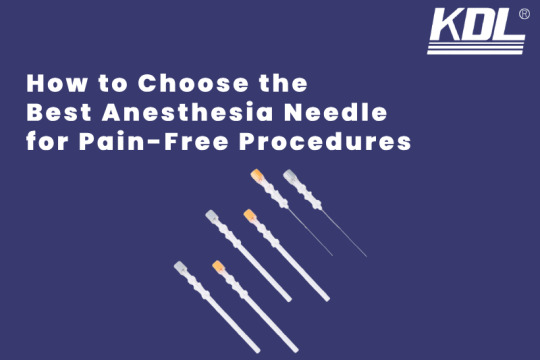
Ensuring patient safety and comfort is crucial for any medical procedure, and choosing the right anesthesia needles plays a vital role in achieving this. Anesthesia needles are used to administer anesthesia, which numbs the patient’s sensation during a medical procedure. There are various types of anesthesia needles available in the market, and selecting the appropriate one for your patients is crucial. In this blog post, we will discuss how to choose the right anesthesia needle for your patients to ensure their safety and comfort.
What is an anesthesia needle?
An anesthesia needle is a medical instrument used by healthcare professionals to administer local anesthesia to a specific area of the body before a surgical procedure or medical intervention. It consists of a slender, hollow needle attached to a syringe, allowing for the precise delivery of anesthetic medication directly into the targeted area, such as a nerve or tissue. This numbs the area and reduces or eliminates pain during the procedure, ensuring patient comfort and safety.
Types of anesthesia needles
There are three main types of anesthesia needles: spinal, epidural, and peripheral. Spinal needles are used to inject anesthesia into the cerebrospinal fluid surrounding the spinal cord, providing regional anesthesia. Epidural needles are inserted into the epidural space to deliver anesthesia near the spinal cord. Peripheral needles are used for local anesthesia in smaller areas such as fingers, toes, or facial regions.
Factors to consider when choosing an anesthesia needle
Needle gauge and length
The gauge of an anesthesia needle refers to its diameter, with larger numbers indicating a smaller diameter. The length of the needle varies depending on the type of needle and the patient’s body size.
For larger patients, a longer needle may be required to reach the desired injection site. On the other hand, shorter needles are suitable for smaller patients. It is essential to consider the patient’s body size and the area of the body where the injection is to be administered while selecting the needle gauge and length.
Needle tip design
Different needle tip designs are available, such as cutting, bevel, and pencil point. Cutting needles are sharp and cut through tissues, making them suitable for spinal anesthesia. Bevel needles have a sloping tip, making them ideal for epidural anesthesia. Pencil point needles have a rounder tip and are commonly used for peripheral anesthesia. Consider the type of procedure and the patient’s anatomy while selecting the needle tip design.
Material of the needle
Most anesthesia needle is made of stainless steel or plastic. Stainless steel needles are strong and durable, making them suitable for larger patients and more prolonged procedures. Plastic needles are softer and more flexible, making them ideal for smaller patients and shorter procedures.
Patient’s medical history and condition
It is vital to consider the patient’s medical history and current condition while choosing an anesthesia needle. Patients with bleeding disorders or allergies to certain materials may require specific types of needles. Additionally, some patients may have underlying conditions that affect their sensitivity to pain, making it necessary to choose the appropriate needle for their comfort.
Key features of comfort-enhancing anesthesia needles
Anesthesia needle manufacturers have introduced innovative features to enhance patient comfort and procedural efficiency. These features include:
Enhancing precision with Ultrasound-guided anesthesia needles
Ultrasound-guided anesthesia needles incorporate built-in ultrasound compatibility, allowing real-time visualization of needle placement and medication spread. This technology enables practitioners to target specific nerve clusters or injection sites with unparalleled accuracy, reducing the risk of complications and improving patient outcomes.
Prioritizing safety: The importance of safety anesthesia Needles
Safety anesthesia needles are design with built-in mechanisms to prevent accidental needlestick injuries and needle reuse, minimizing the risk of bloodborne infections and promoting healthcare worker safety. These mechanisms may include retractable needles, needle guards, and single-patient use designs.
Optimizing comfort: Ergonomic anesthesia needle designs
Ergonomic anesthesia needles feature user-friendly designs that prioritize practitioner comfort and control during needle insertion and medication administration. These needles may incorporate textured grips, ergonomic handles, and intuitive control mechanisms to reduce hand fatigue and enhance procedural precision.
Navigating needle safety
Ensuring the sterility and safety of anesthesia needle is paramount to prevent infections and protect both patients and healthcare providers. Key considerations for needle safety include:
Ensuring sterility: The role of disposable anesthesia needles
Emphasizing the importance of using sterile, disposable anesthesia needle for each patient encounter to reduce the risk of cross-contamination and infection transmission.
Educating healthcare staff on proper needle disposal procedures and sharps injury prevention techniques to minimize occupational hazards.
Conclusion
In conclusion, selecting the right anesthesia needle is not merely a technical decision but a crucial aspect of patient care. By understanding the diverse options available and considering factors such as gauge, length, and safety features, healthcare professionals can ensure pain-free procedures and optimal patient comfort. Remember, a well-informed choice of anesthesia needle can make all the difference in transforming medical interventions into positive experiences for both patients and practitioners.
Source : How to Choose the Best Anesthesia Needle for Pain-Free Procedures
#Anesthesia needles#Anesthesia techniques#Medical procedures#Anesthesia Insights#Ergonomic design#Anesthesia Selection Strategies#Expert Anesthesia Insights
0 notes
Text
Hospertz: Your One-Stop Partner for Building a Successful Healthcare Facility
Hospertz: Your One-Stop Partner for Building a Successful Healthcare Facility
Streamlining the Journey: Hospertz India Pvt. Ltd. (HIPL) caters to the healthcare industry as a turnkey solutions provider. They offer comprehensive support, guiding medical professionals through every step of establishing a new medical facility.
youtube
From the Ground Up: Their services encompass the entire process, from selecting a suitable location and obtaining necessary licenses to securing funding and attracting investors. They even assist with hiring qualified personnel and developing a strategic marketing plan.
Addressing Modern Challenges: HIPL acknowledges the growing complexities within the healthcare landscape. Their expertise helps navigate the increasing bureaucratic hurdles associated with setting up a new medical establishment.
Experience You Can Trust: With their extensive experience, HIPL has a proven track record of assisting doctors, dentists, and other specialists in building multi-specialty healthcare facilities across India. Their meticulous approachensures every detail is addressed, from acquiring high-tech equipment at competitive prices to recruiting qualified staff.
Focus on What Matters: By partnering with Hospertz, medical professionals can concentrate on their core competency: delivering exceptional patient care. HIPL takes care of the rest, handling day-to-day operations, licensing procedures, streamlining processes, and staff protocols. Their objective is to establish a smooth-running, patient-centric, and profitable healthcare facility.
Realizing Your Vision: HIPL acts as a trusted advisor, providing end-to-end project consultancy and management services. Their comprehensive solutions encompass the entire project lifecycle, from initial concept to final commissioning.
A Guiding Light: Driven by the vision of fostering quality-conscious and profitable healthcare institutions, HIPL leverages its three core strengths:
Physician-Inspired Knowledge: They understand the specific needs and challenges faced by medical professionals.
Unrivaled Technology: They provide access to state-of-the-art equipment and resources.
Impeccable Services: They offer a comprehensive suite of services to ensure a seamless operation.
A Collaborative Approach: HIPL prioritizes client satisfaction. They maintain continuous communication throughout the project, addressing any potential roadblocks and ensuring a collaborative effort towards achieving the desired outcome. Their ultimate goal is to transform your vision for a successful healthcare facility into a reality.
Building Trust: HIPL emphasizes transparency and honesty in all their dealings with clients and investors. They recognize that your vision is paramount, and they strive to make it the cornerstone of their every action.
#hospertz#turnkey solutions#comprehensive support#selecting a suitable location#obtaining necessary licenses#securing funding#attracting investors#hiring qualified personnel#strategic marketing plan#bureaucratic hurdles#multi-specialty healthcare facilities#high-tech equipment#recruiting qualified staff#delivering exceptional patient care#day-to-day operations#licensing procedures#streamlining processes#staff protocols#profitable healthcare facility#end-to-end project consultancy and management services#initial concept#final commissioning#fostering quality-conscious and profitable healthcare institutions#physician-inspired knowledge#unrivaled technology#impeccable services#client satisfaction#continuous communication#collaborative effort#transparency and honesty
1 note
·
View note
Text
#the key terms you might want to use are:#- ZP Nayagarh Recruitment 2024#- Gram Rozgar Sevak Posts#- Nayagarh Job Vacancy 2024#- Apply Offline for Rozgar Sevak#- Nayagarh Gram Rozgar Sevak Application Form#- ZP Nayagarh 2024 Recruitment#- Gram Rozgar Sevak Eligibility#- Nayagarh 156 Job Openings#- Offline Application Procedure Nayagarh#- Gram Rozgar Sevak Selection Process
0 notes
Text
hrrrrng painting is fun but ill die if i dont have every light and color in a separate layer
#i love mixing and sculpting shapes but also its so dreadful to notice somethings wrong and ur only choice being to repaint it#i used to paint a lot back in the day! and i also used to paint things wrong a lot too.#it saved me hundreds of times to have everything on a separate layer but it just isnt the same. procedurally and the final result too#if only it wasnt so painful to select things to fix. or if the transform tool didnt fuck up with the edges so much#its always either too blurry or too crisp or too much work to do.. its so frustrating
0 notes
Note
Hey, I found a beanie boo that I liked the design of but I can't stand those giant uguu eyes. Do you think it would be possible to replace them with smaller safety eyes akin to the old beanie babies? If yes, do you have any advice?
I was gonna answer this in a normal way, but then I got curious about trying it for myself and thought I might as well demonstrate!
So, I went and picked up a guy from the supermarket. The selection there was pretty barren today but I found a decent test subject:

Eye replacement procedure below!
(First of all, to my friend who loves beanie boos, I am so sorry for this lmao)
So! First I opened up the closing seam on his back. However, I found an extra mesh barrier inside! Clearly this is to prevent bean escape since this is the most likely seam to accidentally pop open through play. This would be a bit annoying to work around so I just sewed it back up and went in the back of the head instead…
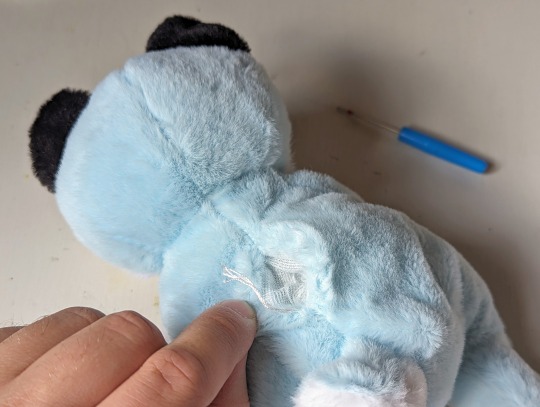
Opened and unstuffed the head…
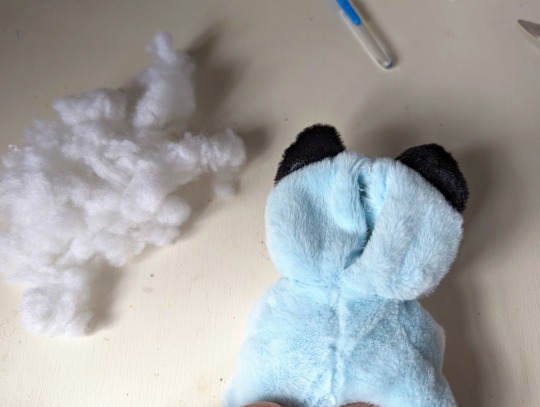
…And turning it inside out to get to the backs of the eyes. Whoa, these plastic washers are the biggest I’ve ever seen!! Cutting through them will take some work!
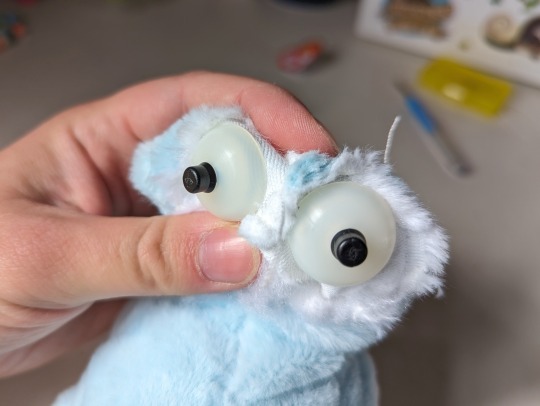
Please be very careful of your fingers cutting through these!! Be careful not to cut the fabric around the eye too, but mostly be careful of yourself!
Anyway grrrrrrr attack attack slice slice grrrr

They’re out! With a little glue I think the washers would be able to hold on perfectly well again. I’ll keep these eyes to reuse on something where they’ll be a bit more proportional!
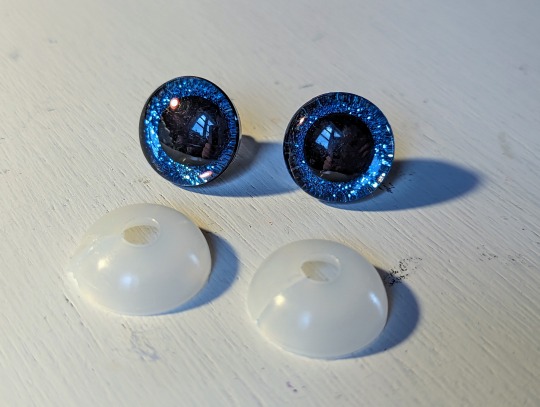
The washers on these eyes are particularly cup shaped, fitting around the back of the eye and holding the fabric tightly against them. Now that the eyes are removed, this has left imprints on the fur!
Plenty of brushing and rumfling will help to fix the creased and flattened areas of fur, and wetting the fur or gently steaming over a hot cup of water should help too. It might take a little time!
(Also, I did make a little cut in the cheek while removing a washer, oops! No worries, that can be stitched up.)
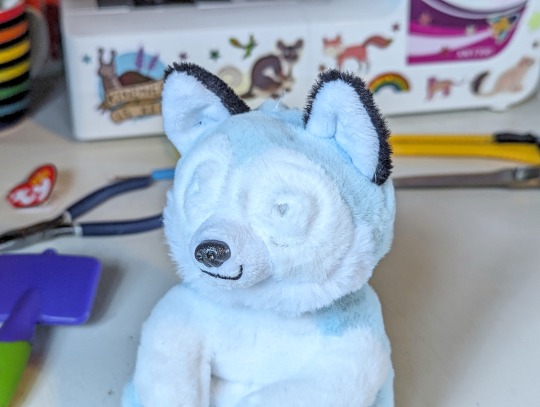
Now we can try on a few new eye styles! Restuff the head for now so you can see how they’ll look.
I have a few sizes of solid black, from teeny dots to absolute tbh creature…



These blue eyes were a little scary… no thanks!

I even have some glittery ones like the original, but smaller! Pretty nice actually!

And even some googly eyes hehehe!

But my favourite eyes were some basic 9mm black ones! They are placed a little funny here, but the position will change a little bit…

The holes left by the original eyes were very big, so a couple of stitches are needed on each one to tighten them up to fit the new eyes. I stitched the top outer corners, to move the holes down and inwards a bit. If you wanted, you could even sew them closed completely and make new eye holes elsewhere!
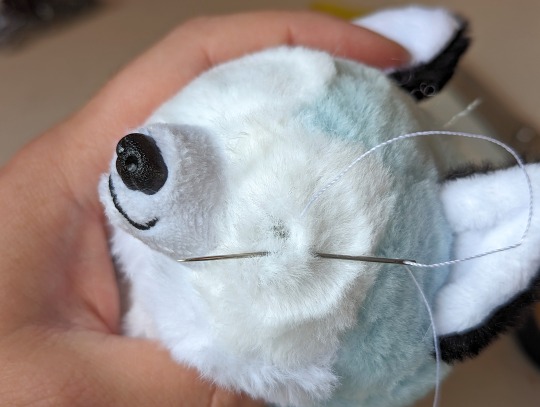
Unstuff again and pop those new eyes in!
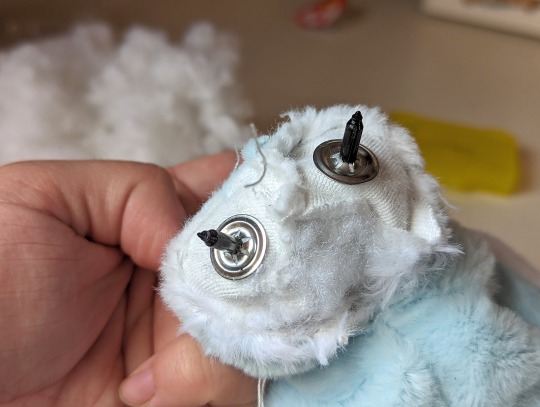
Restuff! You might actually need to add a little extra stuffing, as the fabric not being so pulled around the eyes any more will mean it is a little ‘baggier’.
Then sew the head closed again and that’s about it! The fur is still a little creased around mine, but I’ll keep working at it and it should become less visible.

To add a tiny bit more shape to the big round head, I also did a touch of threadsculpting. I ran a thread from the corner of each eye to below the chin and back, just pulling the eyes in a tad more. You might decide you don’t need this!


And there we go! Hope you’ll try it yourself!
13K notes
·
View notes
Text
Anyway, I'm bringing this back because there's a whole ass post going around about how to tackle the "eugenics abortion" issue that actually doesn't mention the well-being of these disabled children except as a throw away.
We must do away with the nuclear family and we must fundamentally change the societal view of having and raising children in order to come away from "eugenics abortion".
Changing or adjusting what society considers to be the "value" of a disabled child to make it higher and therefore more acceptable to have a disabled child 1) isn't actually about the child and 2) isn't addressing the fundamental issue that children are whole ass human beings and not couches.
Eugenics is explicitly tied to the view of children as "things" that someone owns and controls, and until we do away with that idea, we can never be truly free of eugenics.
And that sucks, but there are a lot of people who claim to be anti eugenics who still very rigidly hold on to the idea of the nuclear family and the "right" to have a child, and that is not and never will be an anti-eugenics opinion, nor will it ever lead to any better conditions for disabled children.
#Can you tell I hate that phrasing#Like it's sooooo interesting how much people who claim to be disability activists center forced/encouraged abortions#To the point where they have to clarify that it's not that they think that people shiuld be ~banned~ from having abortions#Instead apparently the only way to cure eugenics is to have a societal shift to heavily discourage abortions for certain reasons#Like yeah this is where the anti abortion movement started#Then they moved to doctors because that got more play#“We need to give parents more support so they don't feel they need to get abortions”#Do you not hear yourself?#Anyway this is also what I mean when I say that for most people they are incapable of being pro abortion in any way that matterd#Because it takes one “icky” thing or reason for people who claim to be leftists to turn on abortion#To be clear sex selection is even more in this camp which is why people don't talk about it as much except as an extension of misogyny#It's because daughters as things have less value sometimes than sons as things#But people agree with the idea that children are things so their arguments - like here - are about reframing value#And that's just not real#I would say there isn't this kind of “discourse” with other medical procedures#But you know what I was FIGHTING for wisdom teeth removal on Reddit once#Who determines when to pursue preventative medicine and when a procedure becomes necessary#AND WHY ISN'T IT YOU???????
30 notes
·
View notes
Note
Back again inspired by the Roachbunny for the Lost Light and Hot Rod meeting.
———————————————————————
Lost Light drifted in darkness, among small flickering lights, like twinkling stars.
Content.
His world consisted entirely of these little lights, the endless soft void and the Things-To-Do that’d come from inside.
[Set Course for Coordinates 75-300-AER74]
Lost Light drifted through the darkness of space, passing stars that flickered like the little lights that kept him company.
He could see them best when they bobbed on the edges of his consciousness. If he tried to look at any directly, the little lights were too small and too blurry to focus on for long.
That was okay. As long as he had some around he wasn’t lonely. He could even hear them on occasion, like a whisper in another room. Unidentifiable as anything other than a basic form of sound. The kind that always required a question mark attached.
Sound?
They were very noisy today. Enough that the Lost Light could almost remove the question mark. He liked when there was sound, and lights, and Things-To-Do.
[Engage Landing Protocols]
[Open Loading Bay Doors 1-B]
Oh! Many things To Do today.
The little lights began to settle once more. Some disappeared from the grasp of his consciousness.
Sound. Became sound? Became silent again.
The Lost Light drifted in darkness.
New light appeared on the edge of his consciousness. Bright light. Big light.
Lost Light turned his attention to it.
Warm. Bright. Loud.
Lost Light could feel something.
Awe.
Lost Light felt awe too.
Feel? Lost Light didn’t know he could feel things. Warm and bright, the big light bounded across his vision.
The light didn’t disappear into the soft void like the little lights do. It stayed bright and clear and Lost Light could focus on it. The big light felt real and tangible.
Awe and Wonder and Excited pulsed off of the little sun. It was so bright that Lost Light didn’t notice when the big light bounded close to many little lights.
The big light FLASHED in Surprise.
The little lights all started whispering loudly at once.
The big light sped off, leaving a comet trail across his vision. Lost Light followed it, a pang at the thought of it disappearing.
[Engage Lockdown Procedure]
Oh! A Thing To Do. Big day huh. Lots of stuff happening.
As Lost Light began locking everything up, the comet suddenly hit a wall.
Scared.
Oh?
Why?
The big light began bouncing rapidly around. Many little lights were trailing behind them.
[Engage Interior Defenses]
Oh, that made lights disappear. Been a long time since that Thing To Do was a Thing To Do. There were very few lights around after that one for a long time.
[Target Intruder]
Okay dokey.
Lost Light waited for the targeting system to select the intruder. He wanted to go back to focusing on the big light soon.
Want?
Huh. Forgot what want was.
The security systems locked on and-
Big light?
[Fire On Intruder]
The Things-To-Do thingy said.
Afraid. The big light said.
Lost Light was stuck. He was stuck so long that the Thing To Do came again.
[Fire On Intruder]
Huh? Lost Light didn’t complete the last Thing To Do. If Lost Light did nothing, did that mean the Thing To Do wouldn’t happen?
He tested it.
The big light continued to burn bright. So bright in fact, it was starting to show the contours of the Lost Lights soft void.
Halls. Rooms. Engines. Pipes. Wires. Windows. So so so so so much stuff was just sitting there! The whole time!
And he could feel it all.
Why did it feel familiar?
[Fire On Intruder]
[Fire On Intruder]
[Fire On Intruder]
Sheesh! The Things To Do just kept on coming!
And so did the little lights trailing behind the big light.
For the first time in millions of years, Lost Light had something he’d never think he’d have again.
An idea.
If I can do nothing without the Things-To-Do, can I do something without it too?
Lost Light felt for habitual coding and activated it on his own.
A blast door slammed shut, cutting off the little lights from the big light.
Surprise! Came through cleanly. The angry whispers of the others remained muddled and unimportant.
He could feel the big light waver uncertainly. Before a gentle, brushing Hello?
HELLO!
The shockwave of his greeting knocked several of the little lights off completely. The big light only rocked briefly before responding a little louder:
Hello!
HELLO!
Hello!!
HELLO!!!
JoyHappyExcited
JOYHAPPYEXCITEDHAPPYHAPPYJOY
The two of them bounced back and forth for awhile before Lost Light started to have another idea. The more of the void that was burning away (shadow-something, shadow-party?), the more he could feel and think and remember. He could move stuff! A lot of stuff! Because all that stuff? That was his stuff! Stuff made of him!
Lost Light moved walls that hadn’t changed position in a few dozen millennia, rearranging hab suites and hallways until Big Light had a straight shot to where he wanted him to go.
As Big Light trampled through several recently or currently occupied habsuites, Lost Light remembered to shoo out all the little lights before this next bit.
He was a very polite ship you see.
Evacuation sirens blared at just below maximum volume.
Big Light made it to the captains chair, right before the tall panes that made up the very front of Lost Light.
With an almost aching slowness, something began to shift within the ancient ship. Panels opened and unlocked, massive gears began to roll and click into place. Entire thrusters split in half before turning inside out.
Pedes. Servos. Torso. Face.
Senses gone unused for hundreds of thousands of years cycled online.
Lost Light opened his optics. Crossing them, he focused on the Big Light clinging to the bridge of his nose.
The Lost Light smiled at finally being found.
———————————————————————
It’s just too sweet your honor.
Lost Light doesn’t know what’s going on. Everyone else is having varying levels of panic attacks.
Jazz: Did…You know. Lost Light. Was…Uh. A whole… Uh. Guy?
Prowl, Deadlock and Swerve: No.
-SSTP
Oh...oh my god YES PLEASE I LOVE WHEN THINGS ARE DESCRIBED FROM THE POINT OF VIEW OF uhhh how do I say it? Someone who isn't human and in fact very very far from being human and can see the world differently? Something like that?? Like yeah tell me what it's like to be a giant alien sapien space ship SHOW ME I WANNA FEEL IT TOO.

Also I ABSOLUTELY LOVE how these two lovely idiots just keep doing the same hello back and forth to each other it's so so cute kdjfndldkdjj
"He was a very polite ship you see" WHEEEEEZEE. Good job honey you're doing great keep going.
Man, I'm always so entertained by this change of perspective ahahaha. I imagine it's like if you find a spider on your table and try to catch it and move away instead of killing it. You're being very polite and kind and careful while the spider is probably calling it's family to say it's last goodbye because it suddenly started going through giant horrors beyond it's comprehension ahahajkflf
OH AND THAT LAST PART WITH RODDY JUST FUCKING. HANGING THERE KGLFMSN I LOVE IT I LOVEITILOVEITILOVEITSOMUCH
#maccadam#tf mecha universe#mecha writing#mecha lr writing#hot rod#lost light#DAMN THIS WAS SO CUTE#Your writing is charged with emotions it's so fucking cool
450 notes
·
View notes